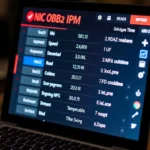Intake air temperature (IAT) and air injection are two crucial elements of your vehicle’s engine management system. The OBD2 system monitors both, ensuring optimal performance and emissions control. This article delves into the specifics of IAT and air injection, their roles, common issues, and how OBD2 scanners help diagnose problems.
Understanding Intake Air Temperature (IAT)
IAT refers to the temperature of the air entering the engine’s combustion chamber. Cooler air is denser, carrying more oxygen, which leads to more efficient combustion and better fuel economy. The IAT sensor, a key component of the engine management system, constantly measures this temperature.
How the IAT Sensor Works
The IAT sensor, typically located in the intake manifold or air intake duct, is a thermistor that changes its resistance based on the air temperature. The Engine Control Unit (ECU) receives this data and adjusts the fuel injection and ignition timing accordingly.
Common IAT Sensor Issues
A malfunctioning IAT sensor can disrupt the air-fuel mixture, leading to:
- Reduced fuel economy
- Increased emissions
- Rough idling
- Hesitation or stumbling during acceleration
The Role of Air Injection
Air injection, also known as the secondary air injection (SAI) system, reduces harmful emissions during cold engine starts. It introduces fresh air into the exhaust manifold, promoting the oxidation of unburned fuel and reducing harmful emissions like hydrocarbons (HC) and carbon monoxide (CO).
Components of the Air Injection System
The air injection system consists of several components:
- Air Pump: Draws in fresh air.
- Air Injection Valves: Control the flow of air into the exhaust manifold.
- Air Injection Passages: Route the air from the pump to the valves and into the exhaust.
- Control Solenoid: Regulates the air pump’s operation based on signals from the ECU.
Common Air Injection System Issues
Problems with the air injection system can trigger the check engine light and lead to:
- Increased emissions
- Failed emissions tests
- Hissing sounds from the engine bay
OBD2 Scanners: Your Diagnostic Tool
OBD2 scanners are essential tools for diagnosing IAT sensor and air injection system problems. These handheld devices connect to your vehicle’s OBD2 port and retrieve diagnostic trouble codes (DTCs) stored in the ECU.
How OBD2 Scanners Help
By reading and interpreting DTCs, OBD2 scanners provide insights into the specific issues affecting your IAT sensor or air injection system. They can also display live data from various sensors, including the IAT sensor, allowing you to monitor real-time values and identify anomalies.
Diagnosing IAT Sensor Problems with OBD2 Scanners
When the ECU detects a problem with the IAT sensor circuit or its readings, it logs a specific DTC. Common IAT sensor DTCs include:
- P0110: Intake Air Temperature Sensor Circuit Malfunction
- P0111: IAT Sensor Range/Performance Problem
- P0112: IAT Sensor Low Input
- P0113: IAT Sensor High Input
- P0114: IAT Sensor Intermittent/Erratic
Using an OBD2 scanner, you can retrieve these codes and further investigate the issue.
Diagnosing Air Injection System Problems with OBD2 Scanners
Similarly, problems within the air injection system will trigger specific DTCs. Some common air injection system DTCs include:
- P0410: Secondary Air Injection System Malfunction
- P0411: Secondary Air Injection System Incorrect Flow Detected
- P0412: Secondary Air Injection System Switching Valve A Circuit Malfunction
- P0413: Secondary Air Injection System Switching Valve A Circuit Open
- P0414: Secondary Air Injection System Switching Valve A Circuit Short to Ground
Conclusion
Understanding your vehicle’s IAT sensor and air injection system is crucial for maintaining optimal engine performance and minimizing emissions. OBD2 scanners are invaluable tools for diagnosing and resolving issues related to these systems, ensuring your car runs smoothly and efficiently.
FAQs
1. Can a bad IAT sensor cause my car to fail an emissions test?
Yes, a faulty IAT sensor can disrupt the air-fuel ratio, leading to increased emissions and potentially causing your car to fail an emissions test.
2. What is the purpose of the air injection system?
The air injection system reduces harmful emissions during cold starts by introducing fresh air into the exhaust manifold, promoting the oxidation of unburned fuel.
3. Can I drive my car with a faulty air injection system?
While your car might still run, driving with a faulty air injection system can increase emissions and potentially damage other engine components over time.
4. How often should I check my IAT sensor?
It’s generally recommended to have your IAT sensor inspected as part of your regular vehicle maintenance schedule.
5. Can I replace the IAT sensor or air injection system components myself?
While it’s possible, these repairs often involve technical knowledge and specialized tools. Consulting a qualified mechanic is recommended for safe and effective repairs.
6. What are some signs of a failing IAT sensor?
Common signs include reduced fuel economy, increased emissions, rough idling, and hesitation during acceleration.
7. Can an OBD2 scanner clear DTCs related to the IAT sensor or air injection system?
Yes, most OBD2 scanners can clear DTCs after repairs are made. However, it’s crucial to address the underlying issue to prevent the codes from returning.
do desal engines vilucals have obd2 connectors
For further assistance with OBD2 diagnostics or to explore a wide range of OBD2 scanners, please contact us via WhatsApp: +1(641)206-8880 or Email: [email protected]. Our dedicated customer support team is available 24/7 to assist you.


